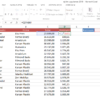Excel
Top 10 Most Used Excel Features: A Detailed Guide
Excel is one of the most widely used tools in business, education, and personal use.
Excel is one of the most widely used tools in business, education, and personal use. It offers a variety of features to enhance productivity and simplify complex data operations. Here are the top 10 most used Excel features and a detailed guide on how to use them:
1. Formulas and Functions
One of Excel’s most powerful features is its formulas and functions. They automate everything from basic mathematical operations to complex calculations.
- Examples:
=SUM(A1:A10),=AVERAGE(B1:B10),=IF(C1>50, "Pass", "Fail") - Use Cases: Financial calculations, statistical analysis, data filtering.
2. Creating and Formatting Tables
Organizing data into tables makes it visually clearer and more functional for analysis.
- Features: Table styles, conditional formatting, cell merging.
- Use Cases: Reporting, data organization, presentation preparation.
3. Data Filtering and Sorting
Filtering and sorting large datasets based on specific criteria are among Excel’s most frequently used features.
- Features: AutoFilter, custom sorting, multi-criteria filtering.
- Use Cases: Customer lists, inventory management, sales analysis.
4. Charts and Chart Types
Excel offers various chart types, such as bar charts, pie charts, and line charts, to visualize data.
- Features: Chart customization, trendlines, data labels.
- Use Cases: Presentations, reporting, data analysis.
5. Pivot Tables
Pivot tables are a powerful tool for summarizing and analyzing large datasets.
- Features: Data grouping, summarization, filtering.
- Use Cases: Sales reports, financial analysis, inventory tracking.
6. Conditional Formatting
Highlighting cells based on specific conditions helps quickly identify trends and key points in data.
- Features: Color scales, data bars, icon sets.
- Use Cases: Performance tracking, budget analysis, project management.
7. Data Validation
Data validation restricts data entry based on specific rules to prevent errors.
- Features: Drop-down lists, number range limits, custom formulas.
- Use Cases: Form filling, inventory entry, data collection.
8. Macros (VBA)
Macros automate repetitive tasks and can be customized using Visual Basic for Applications (VBA).
- Features: Recording macros, VBA coding, automation.
- Use Cases: Reporting, data cleaning, complex calculations.
9. Data Merging and Text Functions
Functions to combine data from multiple cells or split text are highly useful.
- Examples:
=CONCATENATE(A1, " ", B1),=MID(C1, 1, 5) - Use Cases: Address merging, report preparation, data organization.
10. Worksheet Protection and Sharing
Protecting worksheets from unauthorized changes and sharing them with multiple users is essential for collaboration.
- Features: Sheet protection, shared workbooks, permission management.
- Use Cases: Team collaboration, data security, joint projects.
Conclusion
Excel is an indispensable tool for data management, analysis, and reporting, thanks to its wide range of features. By effectively using these features, you can save time and achieve more professional results. Learning Excel and exploring its capabilities will give you a significant advantage in the workplace.
If you’d like more detailed explanations or examples for any of these features, feel free to ask. Mastering Excel is one of the most effective ways to boost your productivity! 🚀















